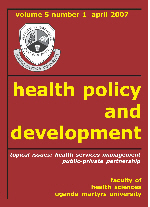
|
Health Policy and Development
Department of Health Sciences of Uganda Martyrs University
ISSN: 1728-6107
EISSN: 1728-6107
Vol. 2, No. 1, 2004, pp. 40-47
|
 Bioline Code: hp04011
Bioline Code: hp04011
Full paper language: English
Document type: Research Article
Document available free of charge
|
|
|
Health Policy and Development, Vol. 2, No. 1, 2004, pp. 40-47
| en |
Financing the Millennium Development Goals: is more public spending the best way to meet poverty reduction targets?
Brownbridge, Martin
Abstract
The strategy for expanding public services through donor funding is flawed and is doomed to fail. Donor funding necessitates increased internal public expenditure. This shifts resources away from the export-oriented private sector, which would bring about economic growth and provide a basis for a more comprehensive poverty reduction. There are also absorptive limitations in the use of large donor aid. Donor funds distort Government's budget allocation pattern, cohesion and stability. The funding gap envisaged under MDGs by donor aid advocates ranges between 6.4% to 13.6% of Uganda's GDP, which are enormous. Large donor aid will lead to contraction of the private sector, appreciation of the shilling and falling prices of agricultural produce. It would mean that the Government would have to depend on donors for over 60% of its budget. And yet donor funding is volatile and unpredictable. The strategy of achieving MDGs through large donor aid should be abandoned. Instead, as projected in the long-term expenditure framework, Uganda should concentrate on the current budget policy to increase economic growth. In 10 years, revenue will have increased by 150% and health expenditure will be about 15% of the Government expenditure.
|
| |
© Copyright 2004 - Department of Health Sciences of Uganda Martyrs University
Alternative site location: http://www.fiuc.org/umu/faculties/hsm/healthpolicy/index.html
|
|
